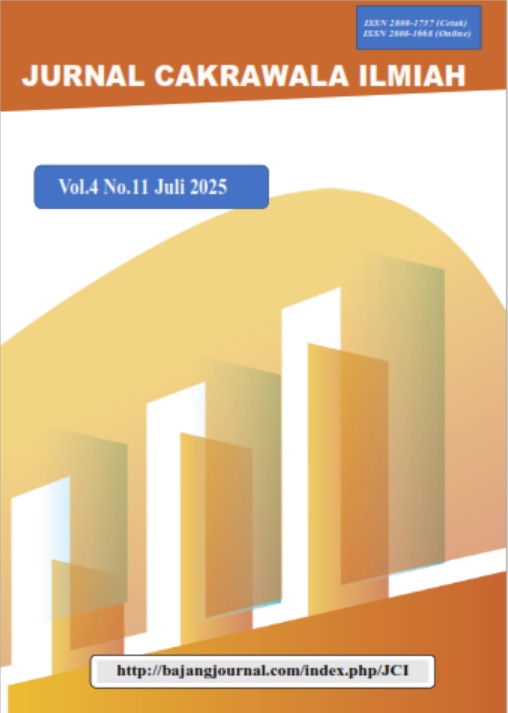REFRAMING THE MAIN CHARACTERS USING NLP TECHNIQUES IN PETE DOCTER’S MOVIE “SOUL (2020)”
Keywords:
Reframing.(NLP), Main Characters, Movie, SoulAbstract
Reframing is a language strategy in neuro linguistic programming (NLP) that changes an individual’s perception by altering the meaning or context of an experience. This study uses Richard Bandler and John Grinder’s (1982) theory of reframing to analyze reframing techniques in Pete Docter’s Soul (2020), supported by language attributes such as modality, lexical, temporal and Pragmatic shift. Language attributes can serve as indicators that reveal how language structure affects a character’s thoughts, feelings, and transformations. This study used a qualitative descriptive approach, examining dialogue and narrative elements to identify reframing expressions and their language patterns. A total of 50 data points were found: 27 positive reframings (54%), 17 neutral reframings (34%), 3 temporal reframings (6%), and 3 situational reframings (6%). The results of the study showed that positive reframing was the most prominent, highlighting its impact on character development and shifts in thought patterns. The process of reconstruction, especially in characters such as Joe Gardner and 22, embodies a deeper understanding of the meaning of life and personal identity, which is constructed through the conscious use of language. This can be very helpful in vulnerable or stressful situation, leading to good communication and how to deal with difficult circumstances.It is hoped that the result is useful for everyone who wants to study about NLP Reframing techniques.
References
Abinaya, K., & Vijayakumar, S. (2022). Communication Skills enhancement throughNeuro-Linguistic Programming: AStudy. NeuroQuantology, 20(6), 9060.behavior link and social interaction. Journal of Personality and Social
Bradley. E. J., & H. Biedermann. (1985). Bandler and Grinder’s neurolinguistic
Burgers, C., Konijn, E. A., & Steen, G. J. (2019). Figurative framing: Shaping public discourse through metaphor, hyperbole, and irony. Communication Theory, 29(4), 410–430. https://doi.org/10.1093/ct/qtz014
Chartrand, T. L., & J. A. Bargh, (1999). The chameleon effect: The perception
Collingwood, C. (2024, January 3). The origins of NLP. Inspiritiv
Fiantika, F., Wasil, M., Jumiyati, S. R. I., Honesti, L., Wahyuni, S. R. I., Mouw, E., & Ambarwati, K. (2022). Metodologi penelitian kualitatif. Metodologi Penelitian Kualitatif. In Rake Sarasin (Issue March). Surabaya: PT. Pustaka Pelajar. https://scholar. google. com/citations.
Fitriani, Y. (2019). The Analysis of Psychological Aspects of The Main Character in Movie “Joker” Based on Sigmund Freud Theory. Humanitatis: Journal of Language and Literature, 6(1), 119-128.
Halliday, M. A. K., & Matthiessen, C. M. I. M. (2014). Halliday’s Introduction to Functional Grammar (4th ed.). Routledge.
Hartati, R., Meisuri, S. A., Ginting, & Ariatna. (2023). Tertiary students’ deficiency in English Emphatic listening skills of NLP matching and mirroring
Hartati, R., Meisuri., Ginting, S.A., & Ariatna. (2024). Menguasai komunikasi dengan NLP. Get Press Indonesia
Imai, M. (2000). Universal ontological knowledge and a bias toward language-specific categories in the construal of individuation. In S. C. Levinson & M. Bowerman (Eds.), Language Acquisition and Conceptual Development (pp. 411–434). Cambridge University Press.
Lakoff, G., & Johnson, M. (1980). Metaphors We Live By. University of Chicago Press.
Natawidjaja, A. (1987). Alfred Adler’s Individual Psychology in Protagonist of “Soul” Movie. Journal of Literature and Psychology. overview and review in the Lenses of Philosophy and Pedagogy. Asian
Pennebaker, J. W. (2011). The Secret Life of Pronouns: What Our Words Say About Us. Bloomsbury Press.
Phiri, A. (2023). Reframing the Black Atlantic. Cultural Studies, 37(2), 191-203.
Pötzsch, J. (2023). Reframing the Dowager: Nostalgia in Downton Abbey.Journal ofe Popular Film and Television, 5(3), 146-154.programming: Its historical context and contribution. Psychotherapy, 22(1), Psychology, 76(6), 893–910
Reeve, J. (2019). Talking to myself: reflections on ReframingA conversation reflecting on my experiences of using creative practice (specifically the Reframing technique) within a STEM context. Higher Education Pedagogies, 4(1), 256-261.
Reif, E., Sap, M., Choi, Y., & Jurafsky, D. (2022). Style transfer and social meaning in NLP. Dalam Proceedings of the 60th Annual Meeting of the Association for Computational Linguistics (hlm. 837–848). ACL. https://doi.org/10.18653/v1/2022.acl short.76
Reif, E., Sap, M., Ippolito, D., Yuan, A., Coenen, A., Callison Burch, C., & Wei, J. (2021). A recipe for arbitrary text style transfer with large language models. arXiv.
Robbins, M. L., Wright, R. C., María López, A., & Weihs, K. (2019). Interpersonal positive reframing in the daily lives of couples coping with breast cancer. Journal of psychosocial oncology, 37(2), 160-177.
Salem, H. A. A., Naeem, M. A. R., Abdelhafez, H. A., Mahmoud, M. S., Sharaf, E. A. E. S., & El-Ghonaimy, T. M. Journal of Research in Curriculum, Instruction and Educational Technology (JRCIET
Searle, J. R. (1969). Speech Acts: An Essay in the Philosophy of Language. Cambridge University Press.
Searle, J. R. (1976). A classification of illocutionary acts. Language in Society, 5(1), 1–23. https://doi.org/10.1017/S0047404500006837
Shaari, A., & A. Hamzah. (2016). Neurolinguistic Programming (NLP): Its
Sharma, A., Liu, X., & Chen, Y. (2023). Linguistic mechanisms in cognitive reframing: A psycholinguistic approach. Journal of Language and Cognition, 15(2), 112–130. technique. SALTeL Journal (Southeast Asia Language Teaching and
Tomasello, M. (2003). Constructing a Language: A Usage-Based Theory of Language Acquisition. Harvard University Press.
Tosey, P., & J. Mathison, (2010). Neuro‐linguistic programming as an innovation
Vaknin, S. (2013). The Big Book of NLP Techniques: 200+ Patterns: Methods & Strategies of Neuro Linguistic Programming. Inner Patch.
Vygotsky, L. S. (1986). Thought and Language. MIT Press.
Whorf, B. L. (1956). Language, Thought, and Reality: Selected Writings of Benjamin Lee Whorf. MIT Press.
Wilimzig, C., & Nielsen, K. (2017). NLP and Psychological Research: Rapport, Reframing and Eye Accessing Cues. Journal of Experiential Psychotherapy/Revista de PSIHOterapie Experientiala, 20(3).
Zamfir, C. M. (2019). Types of (re) framing events and the sleight of mouth technique in the business NLP process. Analele Universităţii Ovidius din Constanţa. Seria Filologie, 30(1), 233-244.
Zhang, X., Davarpanah, N., & Izadpanah, S. (2023). The effect of neurolinguistic programming on academic achievement, emotional intelligence, and critical thinking of EFL learners. Frontiers in psychology, 13, 888797.
Downloads
Published
How to Cite
Issue
Section
License
Copyright (c) 2025 Jurnal Cakrawala Ilmiah

This work is licensed under a Creative Commons Attribution-NonCommercial 4.0 International License.
















